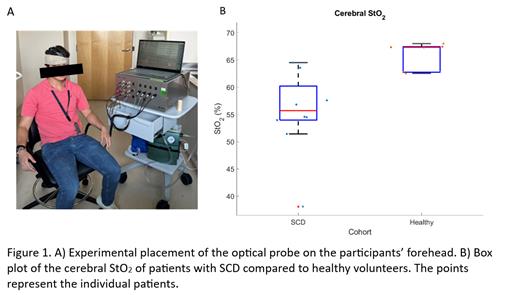Sickle cell disease (SCD) is a genetic disorder that has higher prevalence in people of African ancestry. In the United States, SCD affects about 100,000 people and 1 in 365 African Americans. Sickled red blood cells (RBCs) have a shorter life span and are rigid, causing chronic hemolytic anemia and vaso-occlusive crises. There is a need for accessible diagnostic and monitoring technologies to characterize hemodynamic health, especially for patients with SCD. Near infrared spectroscopy (NIRS) is a noninvasive optical technique that uses light in the near infrared range (650 - 900 nm) to gain information from tissue absorption and light scattering. The purpose of this study is to show that NIRS is sensitive to differences in tissue hemodynamics between patients with SCD and healthy population.
We enrolled adults (age ≥ 18 years) of African descent who were not recently transfused under protocol NCT05604547. Baseline hemodynamics and day-to-day variability were quantified in 10 SCD patients with HbSS (six male, four female) and six healthy, ethnically matched participants (four male, two female). We assessed participants with affixed transmission speckle analysis (ATSA) and a dual system frequency domain-NIRS (FD-NIRS) with diffuse correlation spectroscopy (DCS) device to measure blood flow and hemoglobin concentration. Participants underwent a respiratory challenge, three sets of breath holds, with the optical probe on their forehead. Then, the participants underwent a vascular occlusion challenge, a three-minute brachial blood pressure cuff occlusion at 200 mmHg, with the optical probe on their forearm. We also measured skin and adipose tissue thickness (SATT) of the forearm site with ultrasound. Two of the healthy control participants were excluded from the skeletal muscle analysis due to SATT > 8 mm. A Mann-Whitney significance test was used to evaluate the results.
From these measurements, we acquired the concentration of oxygenated (O 2Hb), deoxygenated (HHb), and total hemoglobin (tHb); blood flow index (BFi); and tissue oxygen saturation (StO 2) for cerebral and skeletal muscle. The cerebral StO 2 in the SCD cohort was lower than the control group, 55.5 ± 7.4% versus 66.9 ± 2.5% (p = 0.003), respectively. Skeletal muscle StO 2 in the SCD cohort was lower than that in control, 59.2 ± 5.8% versus 66.4 ± 6.7%, respectively, but the difference was not significant (p = 0.19). The muscle O 2Hb in the SCD cohort was lower compared to control: 32.7 ± 6.5 µM versus 51.0 ± 9.2 µM (p = 0.01), respectively. The muscle tHb had a similar trend, with the SCD cohort measuring 55.8 ± 12.0 µM and the control group measuring 76.5 ± 9.0 µM (p = 0.03). The SCD cohort was also found to have lower overall muscle BFi, averaging 5.37 x 10 -9 ± 3.47 x 10 -9 cm/s, whereas the control group had an average of 1.90 x 10 -8 ± 1.33 x 10 -8 cm/s (p = 0.004). We also calculated hemodynamic markers, such as components of the occlusion recovery. The post-occlusion O 2Hb recovery slope for the SCD cohort was 0.31 ± 0.19 µM/s compared with control group at 1.56 ± 0.75 µM/s (p = 0.004).
The goal of this study is to compare baseline vascular hemodynamics between patients with SCD and ethnically matched healthy controls. This study is ongoing and preliminary data analysis suggests impaired cardiovascular health in SCD subjects. The cerebral StO 2, muscle O 2Hb, and tHb in the SCD cohort is hypothesized to be a result of the reduced ability of sickled RBC to carry oxygen. There was a significant difference in the cerebral StO 2 but not in the skeletal muscle StO 2, suggesting that there are more dynamic changes seen in the brain than the muscle. This is consistent with previous work using commercial, continuous-wave NIRS systems for a SCD cohort (Barriteau et al. 2022) that also reported significantly lower cerebral StO 2 and lower trending, but not significant, muscle StO 2 values.The post-occlusion O 2Hb recovery upslope is hypothesized to be slower for the SCD cohort due to reduced endothelial function. We plan to assess repeatability of intra-individual NIRS parameters and to compare the non-invasive hemodynamic metrics to clinical markers, such as blood Hb and echocardiogram. These preliminary results indicate that NIRS is sensitive to changes in hemodynamic variations between SCD patients and healthy controls and, therefore, has the potential to serve as a point-of-care technology for individualized clinical management for patients with SCD.
Disclosures
No relevant conflicts of interest to declare.


This feature is available to Subscribers Only
Sign In or Create an Account Close Modal